Riverside Publishing Company, Chicago 1897
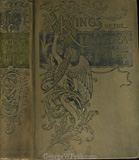
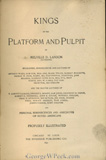
For more information, http://www.georgewpeck.com/kings.html
Riverside Publishing Company, Chicago 1897


For more information, http://www.georgewpeck.com/kings.html
Michael A. Donohue (1841-1915) and William Henneberry founded this company in 1878.
Donohue was born in Ireland in 1841. After living in Philadelphia for a short time, he moved with his family in 1856 to Chicago. He was an apprentice bookbinder with Charles Scott until 1861 when he became a member of the Cox and Donohue firm. Alfred Cox (1835-1910) was a native of England who was active in the bookbinding business from the days of his partnership with Donohue to his death. Donohue’s partnership with Cox ended shortly after the Chicago fire of 1871 destroyed their firm’s place of business. Cox continued as a bookbinder, A. J. Cox and Company, after his work with Donohue ended.
Later in 1871 Donohue became a named partner in Donohue, Wilson (William) and Henneberry, This firm operated until 1878 when it was succeeded by Donohue and Henneberry.
The other named partner in Donohue and Henneberry was William Henneberry (1848-). He was a native of Chicago and had apprenticed as a bookbinder until he joined Donohue in 1871. After the dissolution of Donohue, Henneberry and Company in 1900, he established the Henneberry Company. This latter company became one of the largest publishers of mail order catalogues in the United States.
Initially Donohue and Henneberry was exclusively a bookbinder. By 1879 it was publishing the very popular “Red Line Series”. This was not a series of books however but rather a series of items for schools. By 1887 the Red Line Series included school registers, class records, report cards, diplomas, examination records and writing spellers, etc. In 1887 the Red Line series included catalogues, blank books, ledgers, various forms for schools, certificates, etc., for numerous midwest states. The catalogue was unchanged through 1889.
This firm did print and bind a number of random titles on its own imprint between 1875 and 1889. Many of these were written about Chicago subjects or were the products of local Chicago authors. In 1890 the newly named firm of Donohue, Henneberry and Company began to actively publish books on its own imprint. As with most of the reprint publishers during this era, a majority of its books were published as parts of its publisher’s series.
In 1900 Donohue petitioned a local circuit court to legally help to dissolve the partnership between him and William Henneberry. Apparently the partners had been unable to come to an amicable dissolution of their partnership. Apparently with his sons, Donohue started up a new firm, Donohue Brothers, in April, 1900. Soon after its founding the Donohue Brothers purchased the plates of the W. L. Allison Company, a prominent New York book publisher. By 1901 Donohue had purchased Henneberry’s share, dissolved the Donohue Brothers, and continued the business under the M. A. Donohue and Co. name. Henneberry continued in the book publishing business as the Henneberry Company.
The legal fight between the two partners went on for several years. In 1906 it ended with Donohue being told to vacate its Dearborn Street location or pay a significantly increased rent to Henneberry.
Both the Donohue and Henneberry names continued to be of major import in the book publishing world for many years.
Peck’s Red Headed Boy was copyrighted and published in 1901. The paperback version is #36 in the Belford Series.
Cloth versions were published in both 1901 and 1902. The cloth books were 50 cents and the paperback was 25 cents.
Rose-Belford Publishing Company, Toronto (1878-1883)
The Belford brothers emigrated from Ireland to Toronto in 1857. Charles Belford (1837-1880) was involved in the newspaper business and was editor of both The Leader and later the Toronto Mail. In 1876 he joined with his two brothers Alexander (Aleck) and Robert to form the Belford Brothers. This firm lasted two years and upon Charles’ withdrawal because of ill health, the remaining brothers partnered with G. M. Rose in February, 1878 to form the publishing house of Rose-Belford.
Rose-Belford was best known for The Rose Library which was introduced in 1879. This was the first of a number of series of reprints.
George Maclean Rose (1829-1898) was a native of Scotland. His early training was as a printer. He was involved in the printing trade as a named partner in the Hunter Rose and Company firm. This firm carried on as a printer/publisher for a number of years.
In 1883 Rose-Belford firm was succeeded by the Rose Publishing House. It failed in 1894.
There is evidence that this firm only published one Peck book: Peck’s Fun.
The Peck’s Fun shown here is a transition copy in which the title page imprint is Rose-Belford but the cover page imprint is the Rose Publishing Co. This was probably published in 1883. The Rose-Belford title page indicates an earlier 1881 publication exists. I have not seen that book.
This book is in wraps at 7 x 4.75. There are no illustrations. It has 248 pages.
This firm was the first major publishing house that printed the Peck books. The first edition of Peck’s most famous title, Peck’s Bad Boy and His Pa was published by Belford, Clarke in 1883. It published Peck books between 1880 and 1890. Apparently Belford bought the rights in 1883 to the Peck’s Bad Boy newspaper columns for $1000.
The Belford brothers emigrated from Ireland to Toronto in 1857. Charles Belford (1837-1880) was involved in the newspaper business and was editor of both The Leader and later the Toronto Mail. In 1876 he joined with his two brothers Alexander (Aleck) and Robert to form the Belford Brothers. This firm lasted two years and upon Charles’ withdrawal because of ill health, the remaining brothers partnered with G. M. Rose in February, 1878 to form the publishing house of Rose-Belford.
George Maclean Rose (1829-1898) was a native of Scotland. His early training was as a printer. He was involved in the printing trade as a named partner in the Hunter Rose and Company firm. This firm carried on as a printer/publisher for a number of years.
Alexander Belford left the Rose-Belford Publishing House in 1879 and with James Clarke formed Belford, Clarke in Chicago. Robert Belford followed his brother to Chicago thereafter. In 1879 the company was styled as Belfords, Clarke & Co. The company officially incorporated in 1880 to Belford, Clarke and Company. The firm had a New York branch which was run by Robert Belford. Financial difficulties forced the company into receivership in 1889 and it officially went out of business in 1892.
(A significant number of reference materials claim that the Belfords and James Clarke left for Chicago in 1875 but this is clearly erroneous. It appears that the post-1937 references all are citing “Cheap Book Production” written by Raymond Shove – without attribution. Most likely this errant statement was copied by a number of successive “researchers”. A contemporaneous article in the New York Times from 1889 notes the founding of Belford, Clarke and Co. in 1879. An article in the 1889 American Stationer quoting the same source gives an 1879 date. Other early documents note the 1879 date. The earliest known title page imprints of Belfords, Clarke and Company are in 1879.)
Belford, Clarke and Company published seven George Peck solo authored books. It also published books written by Peck and others. Of the Peck only books six were first editions and one was a second edition. They are listed just below.
For more information, click here.
Musson Book Company, Toronto
This Canadian firm published three Peck books.
One is a combination book which includes Peck’s Bad Boy, No. 1 and Peck’s Bad Boy, No. 2. It was published in 1935. Two different title pages have been seen. One has the 1935 date whereas the other is not dated.
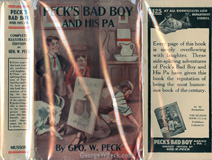 |
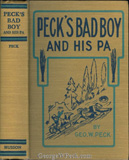 |
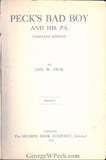 |
 |
Another Musson Peck book is Peck’s Bad Boy and the Groceryman. This 151 page book includes the entirety of Peck’s Bad Boy #2. There are numerous illustrations by True Williams. It is 8 x 5.5.
The date is unknown but there is an inscription in my copy of December 25. 1919.
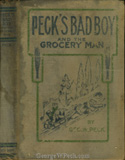 |
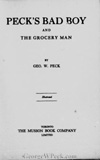 |
Peck’s Bad Boy and His Pa was also published by this company. The exact date is unknown. (Most likely pre-1920)